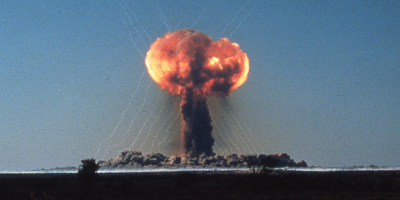Analysis of India’s Nuclear Weapons Program

All Global Research articles can be read in 27 languages by activating the “Translate Website” drop down menu on the top banner of our home page (Desktop version).
***
It is India, not Pakistan with the oldest and fastest growing nuclear program. India enjoys the leverage over Pakistan regarding fissile material estimates because it started its fissile material production more than two decades earlier than that of Pakistan. In 1972, during Multan’s conference at Nawab Sadiq Hussain Qureshi’s ‘White House,’ Bhutto made it clear that he wanted the scientists to be ready to deliver if India exploded the nuclear device. Pakistan was ready, fully knowing Indian intentions, but only decided to start its small scale-cum-indigenous fissile material production after Indian 1974 nuclear tests.
Over years, India has continuously accrued large stocks of Reactor Grade Plutonium (RGPu). Indian placement of eight of its Nuclear Power Plants under IAEA safeguards because of Indo-U.S. nuclear deal. Nevertheless, the spent fuel which was already generated by these reactors is not subject to safeguards. Hence, some of this spent fuel has already been reprocessed and directed to be used for nuclear weapons.
According to the estimates provided by independent scholars, it has been deduced that India has the intentions as well as the capacity to produce at least 356 nuclear weapons. Likewise, even when the fuel needs are met by India for its Fast Breeder Reactor which is 500MW, India is still prepared with the capacity to produce maximum number of 493 weapons. Another alarming evidence paving way to the fastest growing nuclear program is the fact that, by 2039, India will be able to acquire six FBRs. The time when these FBRs will be able to add a surplus of 28 nuclear weapons per year. As these estimates were calculated in 2016, the capacity of India to produce such weapons will have only increased, considering its operational nuclear triad. This has resulted in blind eyed uncapping of the oldest, biggest and fastest growing nuclear arsenal among non-NPT nuclear weapon states.
India is in a process to build a clandestine nuclear city in Chakkakere. One of the motivations behind this nuclear city is to acquire additional enriched uranium fuel for consumption by Indian thermonuclear weapons. According to a report, it is debated that India will be able to retain 1050 enrichment machines in its Saperative Work Units (SWU) in addition to older 700 centrifuges.
Herewith, India could attain 42000 SWUs per year. This will be more than enough to harvest Weapon Grade Uranium up to 403 pounds per year. Even when India dedicates INS Arihant with 143 pounds, it will be left with an optimal capacity to fuel approx. 22 thermonuclear weapons.
However, on the other hand, other analysts accurately challenge the aforementioned estimates of enrichment capacity through un-fuzzy math. They state that, from the Rattehalli Rare Materials Plant (RMP) and Bhabha Atomic Research Center’s (BARC) facilities, Indian enrichment capacity sums to 42300 SWUs per year. It is important to note that India needs only 5835 SWUs to 10375 SWUs for its planned nuclear submarines which are 4 to 5 in number. Startlingly, this equates to only 24 percent of India’s total capacity. The remaining 75 percent, i.e. 31925 SWUs will be enough to produce nukes. Once this secret enrichment facility is operative, it will increase Indian enrichment capacity to 100,000 SWUs per year. This was the main reason why India has not kept many of its facilities under IAEA safeguards.
The underplayed estimates of Indian nuclear weapons which discredit Indian intentions to use reactor grade plutonium for nuclear weapons coupled with blind eyed policies of the West towards Indian nuclear modernization can be a sharp coup-de-grâce to the strategic stability in the region.
These false estimates can generate a false narrative of India being a state with no intentions to be a global power (Which is untrue). It is to say that a man has a gun, but, he will never shoot at me. The international scholars need to realize that downplaying Indian nuclear weapon estimates will only lead the foreign policies of major powers astray. This will pose serious challenges for the U.S. in the future where India starts challenging the U.S. when Indian interests start to diverge.
A few western scholars equate the South Asian case to Cold War through Missile Gap Theory. According to this Missile Gap, during Cold War, there was a perception in the U.S. that the Soviet Union was developing and then increasing its nuclear superiority. This led to the U.S. garnering public support to increase defense spending to counter this threat, thereby, fueling arms race.
In contrast, Pakistan does not want to opt for an arms race in South Asia, rather, is defending its stance on the issue via restraint and responsibility. Pakistan’s development of nuclear weapons was and still is driven by regional drivers including Indian hegemonic designs.
*
Note to readers: please click the share buttons above or below. Forward this article to your email lists. Crosspost on your blog site, internet forums. etc.
Ms. Anum A. Khan is a visiting Senior Research Fellow at Strategic Vision Institute (SVI), Islamabad, and a PhD Scholar at Defense and Strategic Studies Department (DSS), Quaid-e-Azam University Islamabad.

